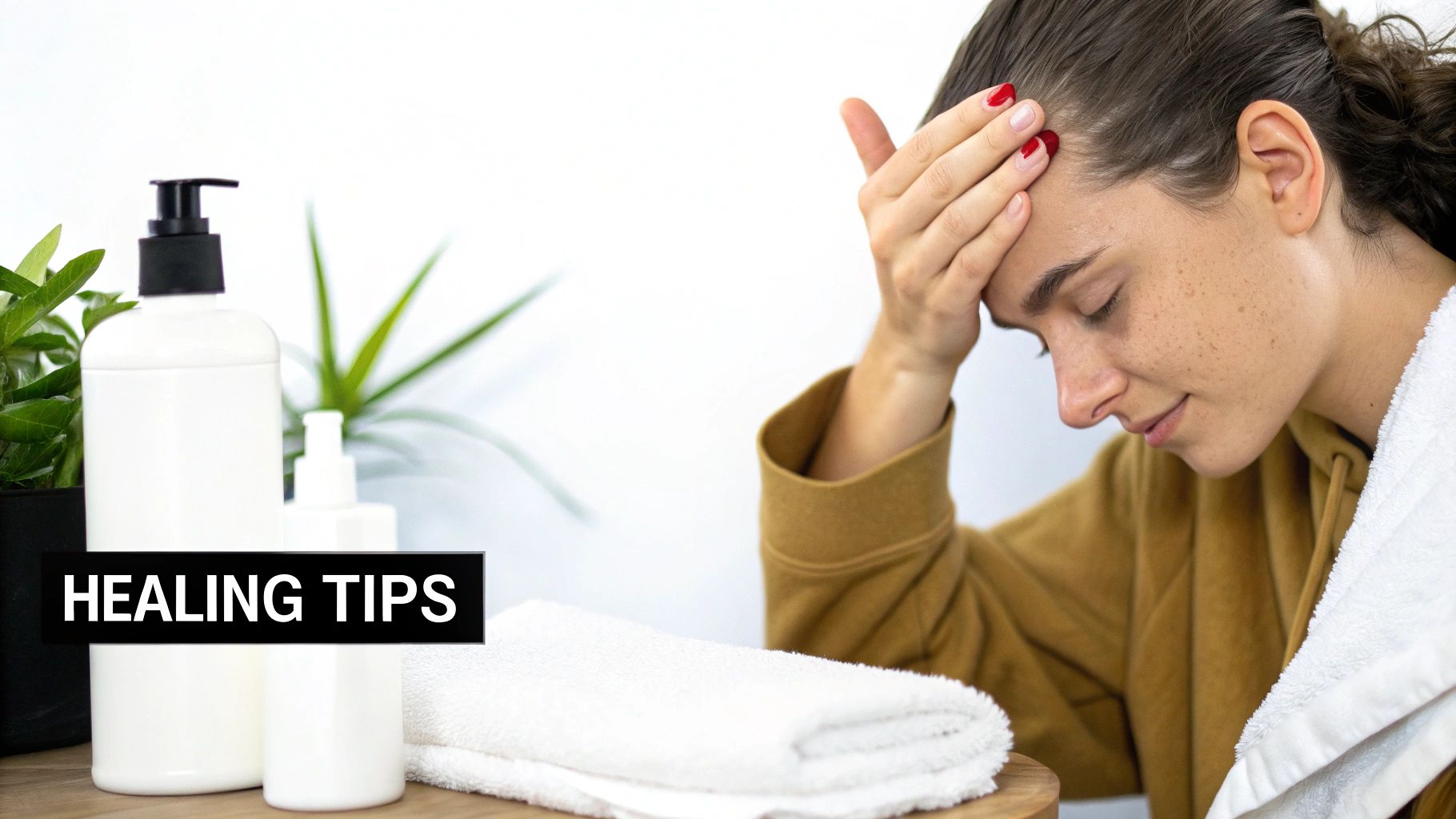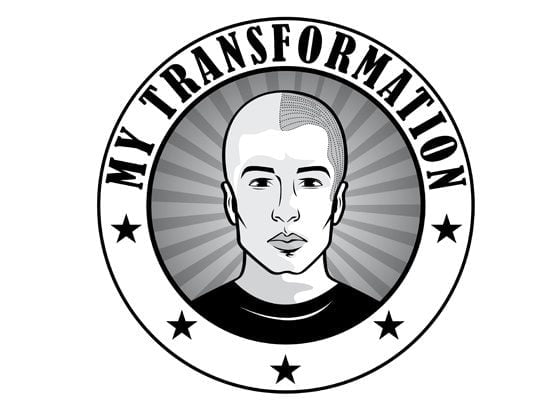
how will my hair tattoo affect my current hair? Learn more
Share
Let's get straight to the biggest question on everyone's mind: is a hair tattoo safe for my existing hair? It's a great question, and the answer is a resounding yes.
A professionally performed Scalp Micropigmentation (SMP) treatment is designed to work with your natural hair, not against it. It's a purely cosmetic procedure that happens on the surface, leaving the important biological processes of hair growth completely untouched.
The Short Answer: Your Hair Is Perfectly Safe
When you're considering SMP, it’s natural to worry about what it might do to the hair you still have. The good news is, the entire process is built around preserving your hair follicles.
Think of it this way: the artist is carefully placing pigment into the upper layer of your scalp’s skin (the dermis). Your hair follicles, however, live much deeper down. The SMP needle never goes deep enough to bother them, meaning your hair will continue to grow just as it always has. It's all about creating a clever illusion of density on the surface without interfering with the real thing underneath.
Where the Magic Happens: Pigment vs. Follicles
So, how does this actually work? The technique uses incredibly fine needles to deposit tiny dots of pigment into the skin. This all happens at a very specific, shallow depth—well above the "root" of your hair follicle.
This careful placement is what makes the procedure so safe. The structures responsible for growing hair are left undisturbed to do their job. It's the core principle of SMP: enhance the look of your hair without getting in the way of its natural function.
The whole point of SMP is to create a powerful visual effect on the skin's surface. It leaves the complex systems beneath—like your hair follicles—to function completely as normal.
Understanding this key difference should give you real peace of mind. SMP is a proven, effective cosmetic solution that complements your existing hair. To get a better handle on the fundamentals, check out our guide on what Scalp Micropigmentation is.
To make it even clearer, here's a quick breakdown of how a hair tattoo interacts with your hair and scalp.
How a Hair Tattoo Interacts With Your Hair
| Aspect | Impact of SMP | Reason |
|---|---|---|
| Hair Follicles | No impact. | Pigment is placed in the upper dermis, far above the follicles. |
| Hair Growth | Unaffected. | The natural growth cycle continues as normal. |
| Existing Hair | Completely safe. | SMP complements your hair; it doesn't harm it. |
| Scalp Health | Minor, temporary redness. | Similar to any tattoo, the skin heals within days. |
Ultimately, SMP is designed from the ground up to be a safe, non-invasive way to restore the look of a full head of hair. It works in perfect harmony with your body’s natural processes.
Understanding the Science Behind a Hair Tattoo
Before we get into how a hair tattoo might affect your existing hair, it's worth getting your head around the technique itself. Scalp Micropigmentation isn't like a traditional body tattoo; it's a highly specialised cosmetic procedure designed with incredible precision and safety in mind.
The whole process involves a trained technician using microneedles to deposit thousands of tiny pigment dots into the scalp. These impressions are placed with real artistry to mimic the look of individual hair follicles, which creates that natural-looking shadow effect and adds the appearance of density.
The Critical Role of Depth
The secret to why SMP is so safe for your hair really comes down to depth. The pigment is placed in the upper dermal layer of your skin, and that’s the most important detail here.
Your actual hair follicles are located much, much deeper in the scalp—far beyond where the SMP needle ever goes. This shallow, controlled application is what ensures your follicles are never disturbed or damaged during the treatment.
A good way to think about it is like aerating a lawn. You’re only working on the very top layer of the soil to improve how it looks, leaving the deep root system completely untouched and healthy. This approach is fundamental to the entire procedure, which you can read more about in our detailed guide on how SMP works for hair loss.
This infographic shows the simple but crucial relationship between the pigment, skin layer, and hair follicle.

As you can see, the whole point is to keep a safe distance between the cosmetic work on the surface and your hair’s biological growth centre down below.
"The entire SMP technique is based on surface-level artistry. By working exclusively in the upper dermis, we can create the illusion of density without ever interfering with the scalp's natural hair production."
This method is why SMP has become such a trusted solution right across Australia. Thousands of Aussies have opted for this treatment because it's designed from the ground up to blend with and complement the hair they already have, not harm it. The goal is always to enhance what you've got—safely and effectively.
How SMP Works With Your Natural Hair Growth Cycle
It’s a question I hear all the time: "Will the hair tattoo mess with my existing hair as it grows and sheds?" And it's a great question. After all, your hair is constantly in motion—growing, resting, and renewing—while a hair tattoo is a fixed, cosmetic treatment. How do the two actually work together?
The secret is that they operate on completely different levels. Your hair follicles are anchored deep down in your scalp, pushing out hair shafts in a predictable, three-stage cycle. Scalp Micropigmentation, on the other hand, involves placing pigment into the upper dermis of your skin, a layer well above where all that follicular action happens.
Because of this separation, your natural hair simply keeps doing its thing. It will grow right up through the pigmented areas without any problem at all.
A Foundation for the Future
Good SMP isn't just about filling in the gaps you see today. A truly skilled practitioner is creating a lasting foundation of density that anticipates what your hair might do in the future.
This is what separates an average treatment from a great one. We’re building a subtle "shadow" on the scalp that will look natural and consistent, even if you continue to thin out over time. The SMP acts as a permanent baseline of fullness, making sure your look holds up for years.
The real art of SMP is planning for the long term. A great treatment looks seamless today and continues to provide a confident, full appearance years from now, regardless of what your natural hair does.
This forward-thinking approach is precisely what makes SMP such a reliable and clever solution. It’s designed to work with your body’s natural processes, not fight against them. Your hair will keep growing, resting, and shedding just as it always has, totally unaffected by the pigment sitting just above it.
If you're curious about the specifics of these phases, you can learn more about the hair growth cycle in our detailed guide.
Ultimately, your hair follicles and the SMP pigment exist in two different worlds. One is a biological process happening deep within the scalp, and the other is a clever cosmetic enhancement on the surface. It's this clever separation that keeps your existing hair healthy while ensuring your SMP looks fantastic for years to come.
How the Healing Process Affects Your Hair

Once your SMP session is done, your scalp kicks off a healing process. This is a critical time, both for locking in that new pigment and for looking after your existing hair. Knowing what’s coming makes the whole experience feel much more straightforward.
Right after the treatment, expect a bit of redness and tenderness. This is totally normal—it’s just your skin's natural reaction to the microneedles. Think of it like a mild sunburn that usually disappears within 24 to 48 hours. The good news is your existing hair isn't affected at all, as the work is all on the upper layer of your skin.
Aftercare Is Everything
Getting the aftercare right is non-negotiable if you want the best result. It’s what ensures the pigment settles perfectly and your hair follicles stay healthy and happy. A few simple rules are all it takes.
For the first few days, your main goal is to protect your scalp from anything that might disrupt the healing.
- No Washing: Hold off on washing your scalp for at least 3-4 days. This gives the tiny pigment dots time to properly scab over and set.
- No Sweating: Skip the heavy workouts, saunas, and anything else that makes you sweat a lot.
- Avoid Harsh Products: Don't use any shampoos or styling products with harsh chemicals or alcohol until you're given the all-clear.
- Stay Out of the Sun: Fresh pigment can fade with direct sun exposure, so a hat is your best friend when you’re outdoors.
Following these instructions is the single most important thing you can do to protect your investment. It creates the perfect environment for the pigment to heal while keeping your scalp and existing hair in prime condition.
For a complete rundown, our day-by-day scalp micropigmentation healing timeline guide gives you an in-depth look at what to expect as you recover. Sticking to the plan ensures your new look and your native hair will get along perfectly.
Long-Term Styling and Maintenance

After the initial healing phase, your hair tattoo and native hair begin their long-term partnership. This is when the real magic of Scalp Micropigmentation becomes part of your everyday look. Think of the SMP as a permanent shadow or base layer on your scalp, cleverly closing the visual gap between your skin and your hair.
This simple effect is what makes thinning areas look so much denser and fuller. It’s a game-changer for styling. You get a consistent foundation of fullness that supports whatever look you’re going for, whether it’s a sharp buzz cut or adding density to longer hair.
Keeping Your Look Fresh for Years
Just like any high-quality tattoo, your SMP needs a little upkeep over the long haul to stay looking its best. The biggest factor is usually sun exposure, which can cause the pigment to soften and fade over time.
To keep everything looking crisp, most clients come in for a simple touch-up session every 3 to 6 years. It’s a quick and easy process, basically a mini version of your original treatment. This small bit of maintenance ensures your hair tattoo remains sharp and completely natural-looking for years to come.
This kind of long-term thinking is becoming more common across Australia. The entire tattoo industry is growing, and cosmetic procedures like SMP are a big part of that. In fact, projections show the market could triple by 2034, with cosmetic tattooing expected to grow at 12.1% annually. You can dig into these Australian tattoo market insights if you're curious about the trend.
Maintaining your SMP is about protecting your investment and ensuring you feel confident in your look for years to come. A brief touch-up every few years is all it takes to keep the illusion of density flawless.
Ultimately, keeping your SMP looking great is straightforward. A good artist also plans for the future right from the start, considering how your hair tattoo will look as you get older to ensure it always complements you.
Common Questions About Hair Tattoos and Existing Hair
It’s completely normal to have a few questions still buzzing around, even after you understand the science behind it all. Deciding to get SMP is a big step, and you want to be sure about every little detail.
Let’s get into the practical side of things. Here are the clear, straightforward answers to the questions we hear from clients every single day, so you can feel totally confident about how a hair tattoo will work with your hair and lifestyle.
Can I Still Dye My Hair After SMP?
Absolutely. Once your scalp has completely healed from your final session, which usually takes about 3-4 weeks, you can go right back to your normal colouring routine.
Think of it this way: hair dye coats the hair shaft, while the SMP pigment sits just below the surface in your scalp's dermal layer. They’re on two different levels and won’t interfere with each other at all. The only crucial step is waiting for the healing to finish to avoid irritating your skin.
What if I Want a Hair Transplant Later?
This is a great question and one we get a lot. Getting a hair tattoo doesn't close the door on a future hair transplant. In fact, many people use both procedures together to get the best possible look of density and fullness.
Here’s how they complement each other:
- Hiding Scars: SMP is fantastic for camouflaging the fine linear or dot scars left behind from FUT or FUE hair transplants.
- Boosting Density: The hair tattoo adds a shadow effect that fills in the spaces between transplanted hair grafts, making the final result look much thicker than what a transplant can do on its own.
The two treatments are perfectly compatible. Just be sure to let your transplant surgeon know you've had SMP so they can factor it into their plan.
A hair tattoo is a cosmetic enhancement, not a medical barrier. It's designed to be a flexible, long-term solution that can adapt with you, whether that means working alongside other treatments or simply looking great on its own.
Will I Have to Shave My Head for the Treatment?
This really comes down to your pattern of hair loss and the style you're going for.
If you have major balding on the crown or a receding hairline and want that sharp, clean buzz-cut look, then yes, you’ll need to keep your head shaved. This is what creates that seamless blend between the SMP dots and your real hair stubble, making it undetectable.
But if you have longer hair and are just using SMP to make thinning areas look denser, you won't need to shave your head. A good practitioner can work carefully between your existing hairs, building up that underlying shadow to create the illusion of thickness.
At My Transformation, we believe in giving you clear, honest answers so you can make a choice that truly boosts your confidence. If you have more questions or are ready to see what SMP can do for you, book a free consultation with us today.
